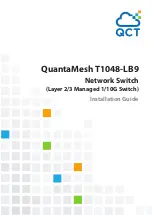
28
SNMP C
ONFIGURATION
SNMP Configuration
Introduction
The Simple Network Management Protocol (SNMP) has gained the most extensive
application in the computer networks. SNMP has been put into use and widely
accepted as an industry standard in practice. It is used for ensuring the transmission
of the management information between any two nodes. In this way, network
administrators can easily search and modify the information on any node on the
network. In the meantime, they can locate faults promptly and implement the fault
diagnosis, capacity planning and report generating. SNMP adopts the polling
mechanism and provides the most basic function set. It is most applicable to the
small-sized, fast-speed and low-cost environment. It only requires the unverified
transport layer protocol UDP; and is thus widely supported by many other products.
In terms of structure, SNMP can be divided into two parts, namely, Network
Management Station and Agent. Network Management Station is the workstation
for running the client program. At present, the commonly used NM platforms include
Sun NetManager and IBM NetView. Agent is the server software operated on
network devices. Network Management Station can send GetRequest,
GetNextRequest and SetRequest messages to the Agent. Upon receiving the requests
from the Network Management Station, Agent will perform Read or Write operation
according to the message types, generate and return the Response message to
Network Management Station. On the other hand, Agent will send Trap message on
its own initiative to the Network Management Station to report the events whenever
the device encounters any abnormalities such as new device found and restart.
SNMP Versions and
Supported MIB
To uniquely identify the management variables of a device in SNMP messages, SNMP
adopts the hierarchical naming scheme to identify the managed objects. It is like a
tree. A tree node represents a managed object, as shown in the Figure 165. Thus the
object can be identified with the unique path starting from the root.
Figure 165
Architecture of the MIB Tree
The MIB (Management Information Base) is used to describe the hierarchical
architecture of the tree and it is the set defined by the standard variables of the
monitored network device. In Figure 166, the managed object B can be uniquely
specified by a string of numbers {1.2.1.1}. The number string is the Object Identifier of
the managed object.
A
2
6
1
5
2
1
1
2
1
B
Summary of Contents for 5500 SI - Switch - Stackable
Page 24: ...24 ABOUT THIS GUIDE...
Page 50: ...50 CHAPTER 1 GETTING STARTED...
Page 54: ...54 CHAPTER 2 ADDRESS MANAGEMENT CONFIGURATION...
Page 78: ...78 CHAPTER 3 PORT OPERATION...
Page 88: ...88 CHAPTER 4 XRN CONFIGURATION...
Page 122: ...122 CHAPTER 8 VLAN VPN CONFIGURATION...
Page 216: ...216 CHAPTER 15 SSH TERMINAL SERVICES...
Page 268: ...268 CHAPTER 16 IP ROUTING PROTOCOL OPERATION...
Page 308: ...308 CHAPTER 17 NETWORK PROTOCOL OPERATION...
Page 349: ...349...
Page 350: ...350 CHAPTER 18 MULTICAST PROTOCOL...
Page 522: ...522 CHAPTER 22 FILE SYSTEM MANAGEMENT...
Page 584: ...584 CHAPTER 30 PASSWORD CONTROL CONFIGURATION OPERATIONS...
Page 600: ...600 CHAPTER 31 MSDP CONFIGURATION...
Page 614: ...614 CHAPTER 32 CLUSTERING...
Page 670: ...670 CHAPTER C AUTHENTICATING THE SWITCH 5500 WITH CISCO SECURE ACS...
















































